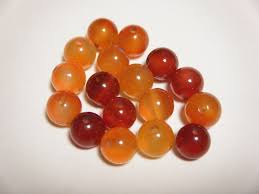Sardius, sardion, Carnelian
The sixth Foundation Stone of New Jerusalem.

‘Odem’, literally ‘redness’ or ‘red stone’, is the stone listed as the first stone in the ‘breastplate of judgement’ in Exodus. ‘Odem’ was translated into the Greek word ‘sardios’ which is the sixth stone of New Jerusalem. According to Pliny the Elder, sardius derives its name from the city of Sardis in Lydia, but it more likely comes from the Persian word sered, meaning yellowish-red. ‘Odem’ here could have been any one of several red stones known to the ancient Hebrews: the garnet, red jasper, or even red coral, as well as the sardius (carnelian). It is possible that ruby was meant but this is the least likely possibility, because rubies were not well known or at all common at this time, the artifacts found dating back to 300 B.C..
‘Carnelian’ is the modern word for the stone translated as ‘sardius’ in the KJV. Carnelian is a translucent, hard, fine-grained variety of orangish red quartz that has often been used for ring stones and wax seals. Carnelian has been frequently discovered in excavations of the ancient tombs of royalty. A necklace more than 10 feet long and containing 670 orange-red carnelian beads was found in the tomb of a queen dating 1000 BC. A string of expertly carved carnelian beads was found in Egypt dating back to 3100 BC. Sard was used for Assyrian cylinder seals, Egyptian and Phoenician scarabs, and early Greek and Etruscan gems.
The word ‘garnet’ comes from the Latin ‘granatum’ (the pomegranate) having to do with the red color of the stone. It is a brittle, hard, glassy, mineral silicate. Though the word ‘garnet’ is not found in any of the translations of the Bible, garnets were a common stone in Biblical times. The garnet has been found as early as the Bronze Age, in Egyptian jewelry, dating back to 3100 BC. The Greeks used garnets as signet rings with found artifacts dating around 400 BC. Due to their color, garnets have been closely associated with blood, as have other stones that are red. They also have the distinction throughout history of often being mistaken for rubies.
Coral is a limestone formation of calcium carbonate produced by the skeletons of millions of tiny marine animals (polyps). Because it is of animal origin it is not technically considered a mineral. Gem quality coral or precious coral is only found in a few places in the world, one being the warm waters of the Mediterranean Sea which produces some of the very finest. It is unique in that it has an internal skeleton which can be polished bringing out it’s beautiful shades of red. It grows in bush-like clumps of branches about a foot high and must be harvested while still living to preserve the color. If the polyps die before a branch reaches the surface, the coral turns dark and loses its value. This precious coral has been harvested from the earliest times and prized by many civilizations. Many specimens of polished branches mixed artfully with beads have been discovered in early Egyptian jewelry. Coral is mentioned several places in the Bible (scripture references vary according to version). Discrepancies are common with gemstones because the meanings of some of the original words have been lost over time.
Rubies are the red gem variety of the mineral corundum. Rubies get their red color from traces of chromium. All other colors of corundum are called sapphire. Rubies are the among the hardest of the gemstones with only the diamond being harder. Called “king of the gems” in some ancient cultures, rubies are considered the rarest and most precious gemstone in the world. They are generally not as large as some of the other gemstones. While sapphire, diamond and emerald gems weighing hundreds of carats exist, high quality rubies of even 20 carats are rare. The price of a gem-quality ruby will far exceed the price of a diamond of the same size. Rubies did not come into use until the Roman Empire around 300 BC. There have been no rubies (or diamonds or sapphires) found in any excavations of early Egyptian civilization. There are several places in the Old Testament where ruby is the term used in the translation of various stones. In these cases it is most likely that some other red stone is the true identification (i.e. red coral, red jasper, carnelian, garnet).
There are quite many ancient beliefs associated with carnelian, which centered around protection during travels, after death, and against evil. Although used to stop bleeding, carnelian was more often worn to prevent skin diseases and insanity. It is also said that this stone will help cleanse and purify the blood, thus giving more physical energy. It was also reputed to bestow courage and eloquence upon the wearer, and was especially recommended for those speaking in public. It also boosts ambition and the courage needed to overcome challenges and difficulties. A stone of power and creativity, it helps you to clarify your goals and find your best direction in life.
One of the earliest writers to associate with the apostles the symbolism of the gems given in Revelations is by Andreas, bishop of Caesurae. He gives a brief description of the stones, which is recounted in George F. Kunz's book The Curious Lore of Precious Stones (1913). The sardius, with its tawny and translucent coloring, suggests fire and represents Philip.